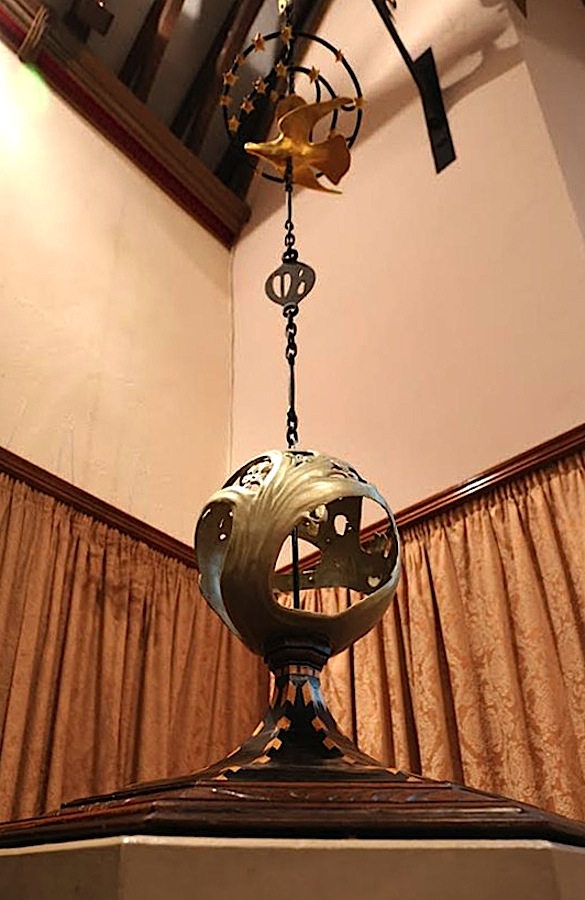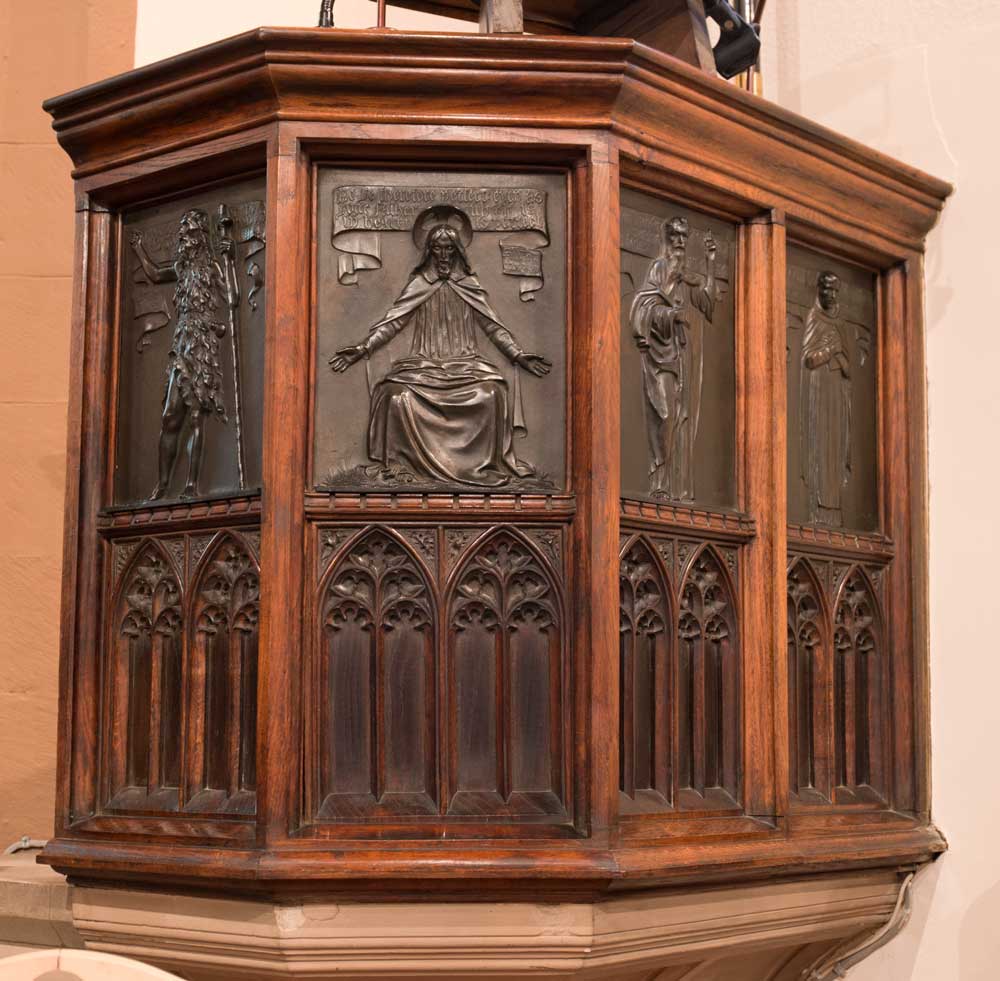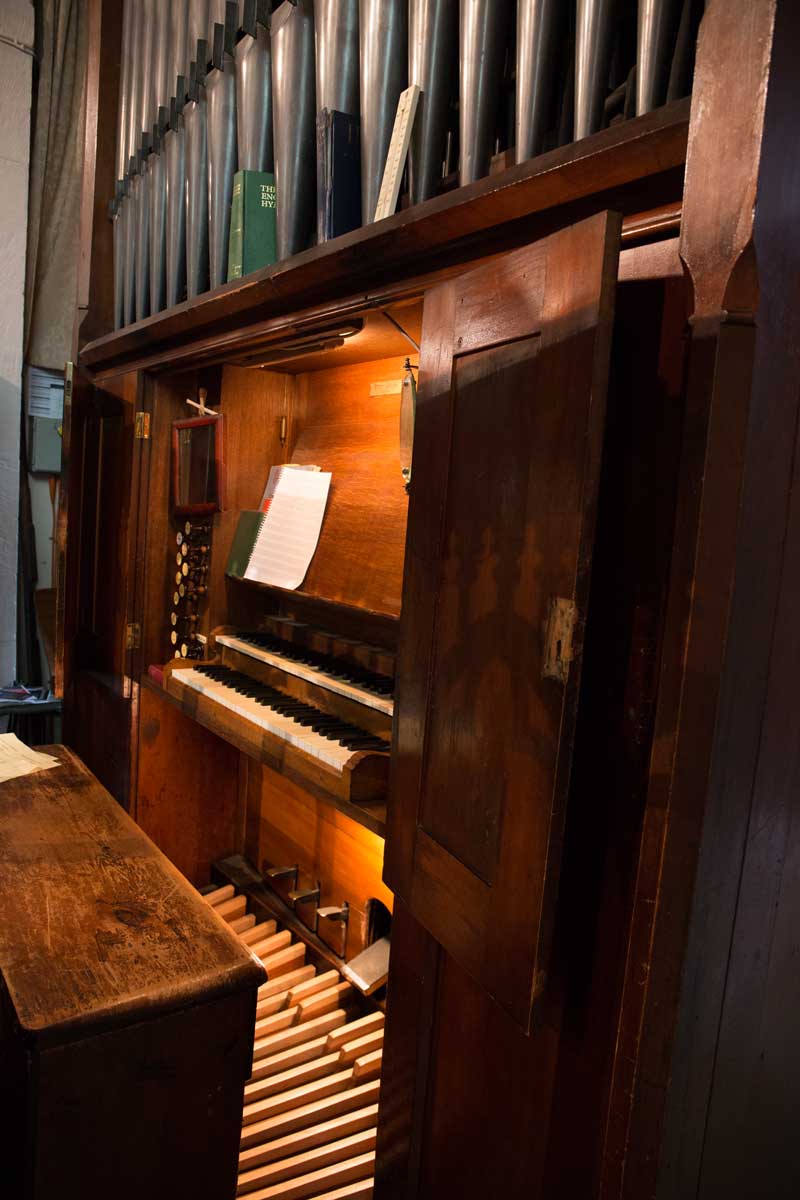Photographs and caption material by Michael Critchlow, who also kindly provided material about individual items from the church's own notes (available at St Martin's). Text by Jacqueline Banerjee. You may use these images without prior permission for any scholarly or educational purpose as long as you (1) credit the photographer and (2) link your document to this URL in a web document or cite the Victorian Web in a print one. [Click on all the images to enlarge them, and see the details.]
High Altar and Chancel Cross


Left: Reredos by J. D. Sedding, showing the Road to Emmaus on the left, and the Last Supper on the right. Right: Chancel cross by gold- and silversmith Omar Ramsden.
The fittings of St Martin's Church, Brabyns Brow, Low Marple, near Stockport in Greater Manchester are fine examples of Arts and Crafts design and workmanship. The church's Grade II*
Lady Chapel



Left to right: (a) Inlaid altar table by Henry Wilson. (b) Low screen by Henry Wilson. (c) Reredos by Christopher Whall.
The Lady Chapel altar table, with its elegant patterning of different types of wood, has a gilded relief bust of Jesus at the Last Supper, and the low screen or communion rail in front of it has a similar but bolder feature of wood marquetry. The reredos is equally noteworthy, with its pastel painting of Our Lady of Goyt — the river which joins the River Mersey at Stockport — showing Mary being greeted by the angel Gabriel in a local setting. The Holy Spirit in the form of a dove looks down from the embellishment at the top of the frame. The gilded border of foliage here matches the rest of the border of the Lady Chapel apse, with its bird-filled "sky."
The Font



Left to right: (a) The font by Sedding, with upper part by Wilson. (b) Close-up of wooden lid. (c) Close-up of superstructure.
In the listing text, the font is described as having an "Art nouveau ... cover with pierced metal sphere on an inlaid and carved lid." The cover is of oak, and the inlaid woods are ebony and white, making it very attractive. It is also carved with a pattern of fish and waves. On top of this is Wilson's delicate and beautiful metalwork: it seems that the Holy Ghost, in the traditional form of a dove, is hovering over the font, beneath the circlet of the heavens and above the globe of the earth. The encircled "SM" monogram for St Martin's can also be seen at intervals.
The Pulpit




Left to right: (a) Whole pulpit, with Jesus shown centrally. (b) Close-up of John the Baptist, on the left. (c) Close-up of St Paul, on the other side of Jesus. (d) Close-up of St Bernard on the far right.
The pulpit, like the rood screen and the wall plaque of angels here, was almost certainly by Sedding — the church notes tell us that a pulpit exactly answering this description was shown at the second exhibition of the Arts and Crafts Exhibition Society of 1889. It has bronze reliefs of Jesus (with the text, "Be ye therefore perfect, even as your Father which is in heaven is perfect") with John the Baptist ("Repent ye for the kingdom of God is at hand") on one side and St Paul ("Whom therefore ye ignorantly worship, him declare I unto you") and St Bernard ("The end not the battle wins the crown") on the other. These fine reliefs were described in the exhibition catalogue as being the work of the gifted sculptor, Richard Ledward (1857-1890), who died all too young. [Larger image of Jesus.]
The Willis Organ



This lovely organ was designed specially for St Martin's by the famous London company of Henry "Father" Willis, as the gift of local benefactor Miss Stevenson of Cotefield on Hibbert Lane, and was played during the church's consecration service on St Martin's Day (11 November) 1870. It was handsomely restored in 1993.
Other features here, including the stained glass, can be seen by following the links below. The listing text describes the interior of St Martin's as "remarkably progressive"; Sedding's close involvement with the Arts and Crafts movement, and his friendship with Wilson and Whall, both of whom he helped to establish themselves, have produced a church radiant with rare craftsmanship.

North door handle with Art Nouveau design.
Related Material
- Exterior of the church
- Interior of the church
- Panel of angels by Sedding
- Della Robbia lunette
- St Christopher relief by Wilson
- War Memorial Plaque by Wilson
- Windows here by Morris
- Windows here by Whall
- Windows here by Herbert Bryans
- Window here by A. K. Nicholson
Bibliography
"Church of St Martin, Marple." British Listed Buildings. Web. 5 September 2016.
"History and Heritage of St Martin's Church." St Martin's Low Marple Heritage Trust. Web. 5 September 2016.
Pevsner, Nikolaus, and Edward Hubbard. Cheshire. The Buildings of England. London: Penguin, 1971 (2001 reprint).
Seccombe, Thomas, rev. Donald Finlay. "Sedding, John Dando (1838–1891), architect." The Oxford Dictionary of National Biography. Online ed. Web. 5 September 2016.
Whittaker, Mark. St Martin's — Low Marple Web. 5 September 2106.
Created 5 September 2016